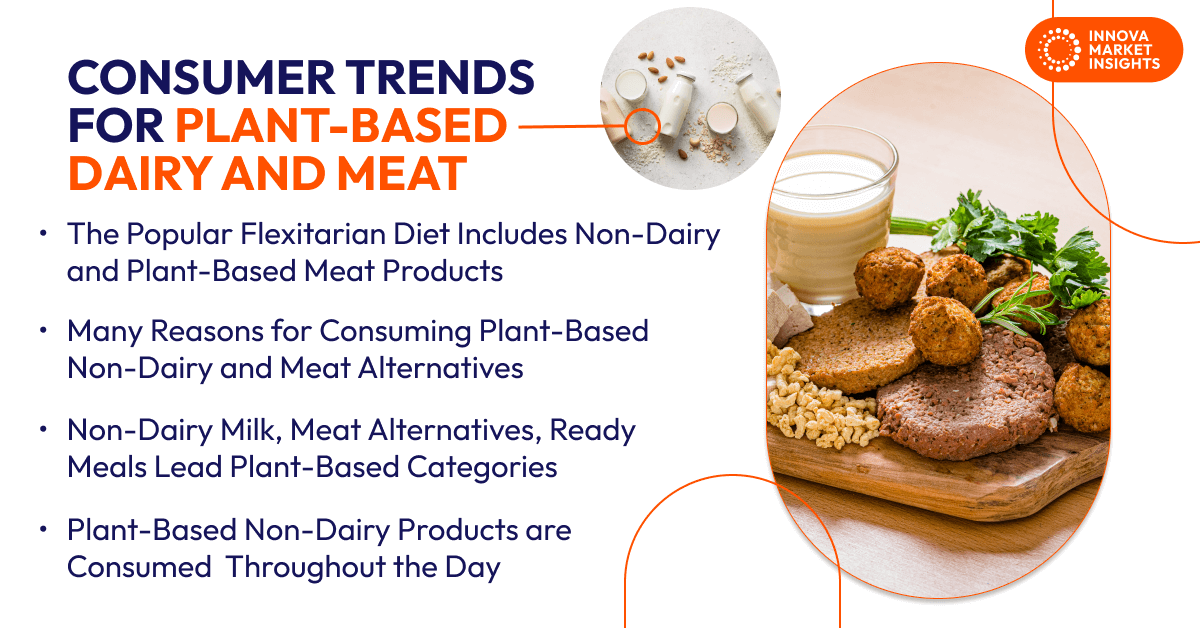Plant-based dairy and plant-based meat are ubiquitous around the world. The dairy category includes plant-based milk and milk drinks, plant-based yogurt, plant-based cheese, and plant-based and vegan butter. Plant-based meat alternatives incorporate plant-based burgers, plant-based meat cuts, plant-based nuggets and finger foods, and vegan meat snacks. Global consumer trends show that consumers have different preferences and buying habits for each.
The Popular Flexitarian Diet Includes Non-Dairy and Plant-Based Meat Products
Non-dairy products and plant-based meat products have a place in popular diets. The flexitarian diet is followed by about one-quarter of consumers globally according to consumer trends data. An even higher proportion of consumers, one-third, follow a flexitarian diet in China. About 10% of consumers around the world are vegetarian, led by two-fifths of consumers in India. About 2% are vegans, led by vegans in India and Germany.
Many Reasons for Consuming Plant-Based Non-Dairy and Meat Alternatives
Plant-based diets often have a more healthy, natural and sustainable image. Naturalness, digestive health and protein intake are the top health-related reasons for consuming dairy alternatives and meat alternatives. However, taste and cost remain major concerns, followed by excess processing and artificial ingredients.
Non-Dairy Milk, Meat Alternatives, Ready Meals Lead Plant-Based Categories
According to consumer trends research, non-dairy, plant-based milk is the most consumed plant-based category globally. Plant-based cheese also is popular. Plant-based milk is most popular in Latin America, Canada, India, Spain, and the UK, while plant-based butter and margarine are the most popular in France and Germany. In contrast, consumers in China and the US report eating plant-based meat the most. Consumers expect to see these products in stores since trends research shows that about half of consumers are more likely to eat plant-based meals at home compared to eating out. Other subcategories expected and enjoyed by consumers are plant-based chocolate and plant-based ice cream and frozen dessert.

Plant-Based Non-Dairy Products are Consumed Throughout the Day
Consumer trends research shows that around one-quarter of consumers surveyed globally say that they buy plant-based dairy alternatives. People who are more likely to buy plant-based dairy alternatives include Millennials, females, and those following a vegetarian or vegan diet. Consumers 25-44 consume dairy alternatives more frequently, including plant-based milk and milk drinks more than once a week. Consumers in North America and Asia Pacific are most likely to pick up plant-based dairy alternatives on grocery trips.
Plant-based non-dairy milk and milk drinks are the most frequently consumed non-dairy alternatives, with 15% of consumers reporting having them at least once a day. The time of day for plant-based dairy varies. Plant-based non-dairy milk/non-dairy milk drinks and non-dairy spoonable/ drinkable yogurt are included most at breakfast. Non-dairy spoonable/drinkable yogurt is also commonly consumed as an afternoon snack. Plant-based cheese is popular at mealtime.
Consumer Research Supports Benefits of Plant-Based Dairy
Consumer trends research shows that consumers want added health benefits such as protein and fiber in plant-based non-dairy products, especially plant-based milk and milk drinks, non-dairy yogurt products, and plant-based cheese. Many consumers prefer the taste and texture of non-dairy alternative milks rather than a product that mimics cows milk. Consumers also appreciate freshness. They are most familiar with and willing to buy plant-based dairy alternatives with a base of rice, almond, coconut, or oat. Despite this, consumers want better taste and flavor in plant-based dairy alternatives, along with lower prices, less sugar and fat, and more protein.
Consumers Buying Plant-Based Meat Alternatives Eat them at Least Once a Week
Approximately one-quarter of consumers surveyed globally report buying plant-based meat alternatives when they shop and over half say they eat them at least once a week. Plant-based meat products are purchased most by vegans and vegetarians, Millennials, and consumers with a doctorate degree. Younger consumers eat meat alternatives most often, especially plant-based meat alternative snacks such as jerky and whole meat cut substitutes. Plant-based meat products are included mostly at lunch and dinner.
Consumer Trends Support Plant-Based Meat Products That are Seasoned and Fresh
Consumers report that fresh, seasoned plant-based meat alternatives that also have health benefits and can be served every day are most attractive to them. Products that are made from a base of rice, potato, corn, bean, or peanut are most appealing. Plant-based burgers and patties are the most preferred format in India, France, Spain and North America; plant-based sausages are preferred in Germany and the UK; breaded/battered meat alternatives are most popular in Brazil and Mexico; and Indonesians like plant-based meatballs.
Globally, consumers expect plant-based meat alternatives to mimic meat in taste and texture. They also would like plant-based meat alternatives with improved taste and texture, more protein, and less fat.
What’s Next for Plant-Based Dairy and Plant-Based Meat?
Sustainability will be a big selling point since around half of consumers globally believe plant-based products are more sustainable than regular dairy and meat. Better animal welfare is the top environmental benefit that attracts consumers to plant-based dairy alternatives and meat alternatives. Environmental claims regarding less pesticide use, less product waste, and reduced water pollution also appeal to a majority of consumers. Also, increased biodiversity is the top reason for consuming plant-based alternatives in the Asia Pacific region.
Manufacturers can grab plant-based opportunities to improve taste, boost nutritional value, and expand options for products featuring local cuisines in meal packages and ready meals for added convenience.
This article is based on our Consumer Insider report, “Charting the Path Forward: Future Horizons for Plant-Based Consumers Worldwide.” If you are interested in reading our report on global plant-based consumer trends, feel free to request a demo. You can do this by either booking a demo or using our Contact Form.